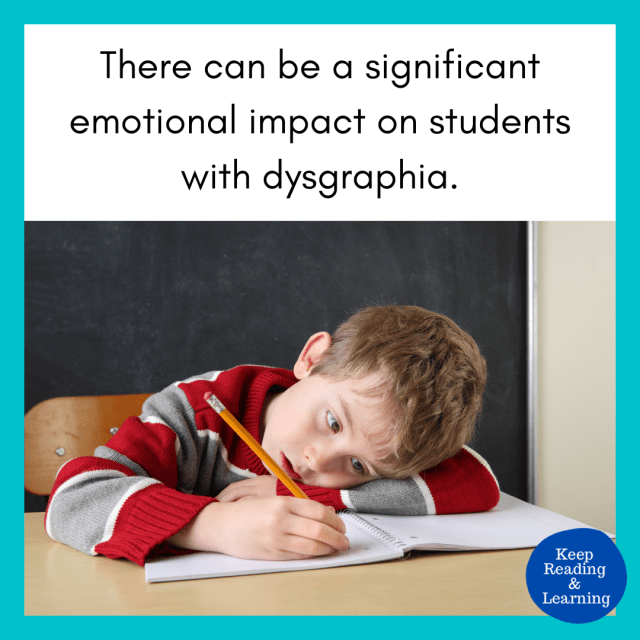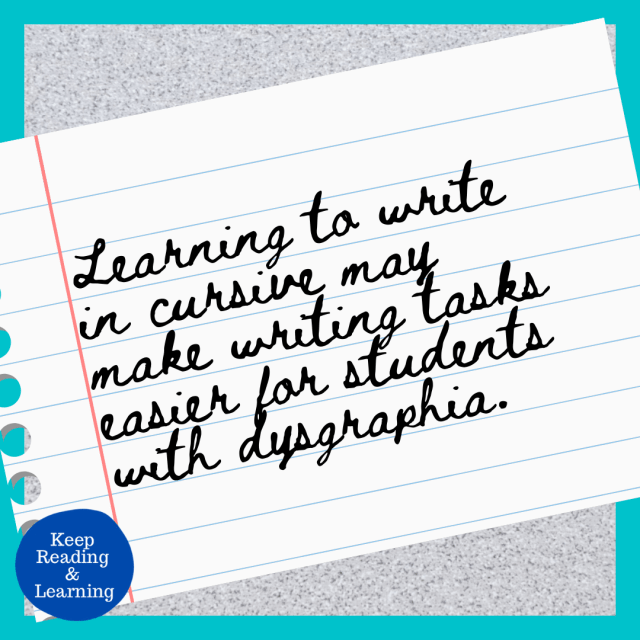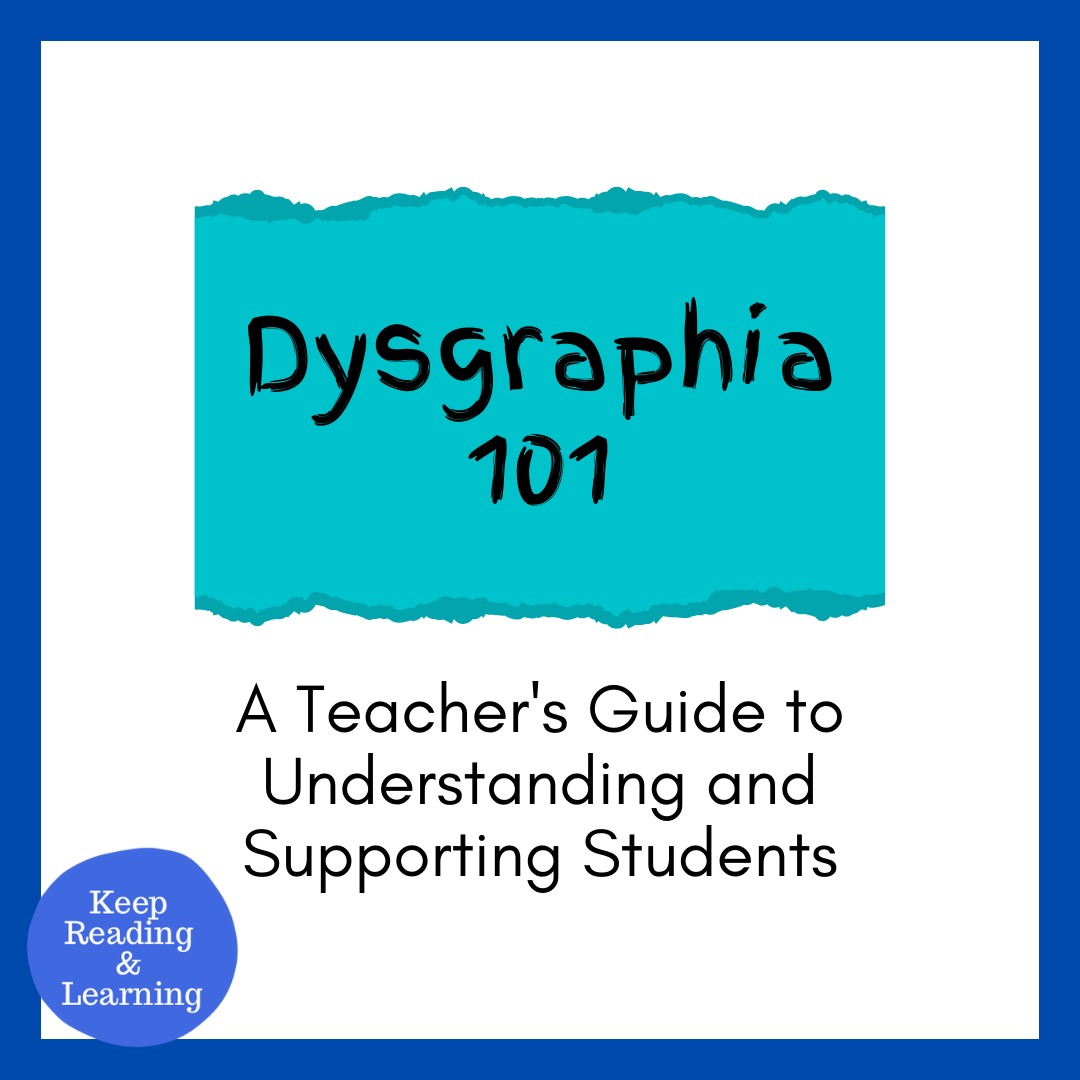Dysgraphia is defined as “the condition of impaired letter writing by hand” or put more simply, “disabled handwriting” (Berninger & Wolf, 2015). However, the specifics of the condition will vary depending on the source you refer to. The term “dysgraphia” is not recognized by the American Psychological Association, so there is no professional consensus on the diagnostic criteria (Chung, et al., 2020).
This post may contain affiliate links.
What are the types of dysgraphia?
Chung, et al. (2020) explain that, depending on who you ask, you may read about three distinct types of dysgraphia: motor dysgraphia, spatial dysgraphia, or linguistic dysgraphia (which may go by other names that will be mentioned later).

With motor dysgraphia, the individual has no spelling weakness, but they demonstrate weaknesses in fine motor skills, including finger tapping speed and strength and endurance for writing tasks.
Individuals with spatial dysgraphia struggle with letter spacing and drawing. Their spelling skills and finger-tapping speed are intact.
A third type of dysgraphia may be referred to as linguistic dysgraphia, dysorthography, or dyslexic dysgraphia. The word dysothography can be broken down into dys– (ill or bad) orthography (correct spelling). It essentially translates to “bad spelling”!

Breaking down linguistic dysgraphia
Stay with me here because this is going to get a little complicated! In linguistic dysgraphia, the main issue is thought to be ineffective communication in what’s called the graphomotor loop. There is a problem with information moving from phonological memory to orthographic memory (from sounds to written letters). Individuals with this type of dysgraphia can draw, copy, and finger tap in an age-appropriate manner but struggle with spelling.
If this sounds familiar, it might be due to the connection with dyslexia. Chung, et al. (2020) explain that it is theorized that dyslexia is related to a weakness in the phonological loop. This would mean that dyslexia is an inefficiency in two-way communication between phonological memory and orthographic memory, rather than just the one-way communication from phonological memory and orthographic memory seen in dysgraphia.

Let’s talk a little more about orthographic memory and how it relates to the more commonly known concept of orthographic mapping. You might already know that orthographic mapping is “the formation of letter-sound connections to bond the spellings, pronunciations, and meanings of specific words in memory” (Kilpatrick, 2016). It’s the way words become sight words. Orthographic mapping occurs at two levels: Orthographic recognition allows a reader to recognize/read a familiar word, while orthographic memory helps a person to spell a word correctly. So if linguistic dysgraphia involves a weakness related to orthographic memory, you can see how a student may struggle to spell words that they can read with ease.
Okay, let’s bring it down a notch now!
Prevalence
It is estimated that 5-20% of the population have dysgraphia. Prevalence statistics depend on which definition is used. Because so many skills are required to produce fluent writing, there are many reasons for individuals to struggle with the writing process that may or may not be due to dysgraphia. An estimated 10-30% of students have difficulty writing, whether or not it is labeled as dysgraphia. We do know that dysgraphia is more common in boys and that 30-47% of children with writing problems also have reading problems (Chung et al., 2020).

How does dysgraphia impact learners?
Dysgraphia can interfere with the development of spelling skills and writing fluency (Berninger & Wolf, 2015). It makes it hard for individuals to express their thoughts and ideas in writing. Writing is a laborious process for people with dysgraphia. Students may struggle to produce work at the same rate as their peers, they may turn in incomplete homework, and they may have difficulty focusing on writing tasks.

There can also be a significant emotional impact for students with dysgraphia! Students who experience a mismatch between their reading and writing skills may feel confused and frustrated because reading comes easily to them but writing does not. And of course, having dysgraphia along with other co-occurring conditions only adds to an already frustrating experience.
What does dysgraphia look like?
Berninger & Wolf (2015) state that students with dysgraphia may exhibit:
- only impaired handwriting
- only impaired spelling in the context of intact reading skills
- or impairments in both handwriting and spelling
Frierson et al. further elaborate that individuals with dysgraphia may form letters and write words incorrectly and produce illegible writing. They may also struggle with spacing between letters and words, writing on the line, writing quickly, and copying accurately and quickly. These characteristics result in a negative impact on sentence structure, paragraph organization, and the overall quality and content of writing.

What are the signs of dysgraphia at various ages?
Chung et al. (2020) provide a list of signs of dysgraphia that may be present across various stages of schooling.

Preschool-aged children:
- An awkward grip or body position when writing
- Tires easily with writing
- Avoidance of writing and drawing tasks
- Written letters are poorly formed, inversed, reversed, or inconsistently spaced
- Difficulty staying within margins
School-aged children:
- Illegible handwriting
- Switching between cursive and print while writing
- Difficulty with word-finding, sentence completion, and written comprehension
Teens and Young Adults:
- Difficulty with the written organization of thought
- Difficulty with written syntax and written grammar that is not duplicated with oral tasks
Is it Developmental Coordination Disorder?
Developmental Coordination Disorder (DCD) is another cause of poor handwriting, but it is not the same as dysgraphia. DCD is “a lifelong condition that makes it hard to learn motor skills and coordination. It’s not a learning disorder” (Berninger & Wolf, 2015).
What are some other diagnoses that co-occur with dysgraphia?
- ADHD
- Dyslexia
- Oral and Written Language Learning Disability (OWL LD)
- Selective Language Impairment (SLI)
Students with dysgraphia should also be tested for these co-occurring diagnoses (Berninger & Wolf, 2015).
Are schools identifying and providing interventions for dysgraphia?
Generally speaking, no. This is likely the case because “dysgraphia is poorly understood and is often undiagnosed” (Chung, et al., 2020). Many sources I found stated that educational settings can identify dysgraphia, but I have not heard of a public school team making this identification. Neuropsychological evaluations completed through a private practice are more likely to reveal a dysgraphia diagnosis, but unfortunately, they can be expensive and have long waiting lists. Or, like me, you may run into another conundrum: the school claims that they cannot diagnose dysgraphia, but your insurance company claims that they cannot cover testing for dysgraphia because the school should be able to assess for it for free!
Although many schools are probably not great at providing interventions for dysgraphia, they are likely to provide accommodations for it. Unfortunately, these students need explicit instruction in addition to accommodations.
What accommodations can support students with dysgraphia?
- allow the student to provide oral answers when their written expression is not being assessed
- employ the use of speech-to-text technology
- offer sentence frames and sentence starters to extend the complexity of the student’s writing and reduce the effort required to compose complete sentences
- reduce the amount of writing the student is expected to produce
- allow extended time for written tasks
- provide support when the student is expected to copy information, such as providing a printed copy of the notes or offering an outline of the notes with blanks for the student to fill in

What does explicit instruction for students with dysgraphia look like?
Instruction may be aimed at preventing or remediating the signs of dysgraphia. Prevention will be important for families with a history of writing problems, but the recommended instruction is also best practice for all early learners. Areas of instruction to focus on for students with dysgraphia include handwriting, spelling, and written composition.
There are two main areas to focus on in the beginning: learning to form letters and automatic letter writing (Berninger & Wolf, 2015).
How can we help students develop letter formation skills?
- activities that strengthen the hand muscles, such as playing with clay
- fine motor control activities like mazes
- letter tracing (connecting dotted or dashed lines) or using a tool like this magnetic letter board or the Magical Handwriting Workbook
- tracing letters with the finger or the eraser end of a pencil
- learning the purposeful, sequential letter strokes to form letters
- copying letters from models
Looking for an engaging way to use the strategies mentioned above? These Uppercase to Lowercase Letter Matching Mazes are perfect for preschoolers, kindergarteners, or older elementary students needing extra practice. Your students will practice several alphabet knowledge skills at once: uppercase and lowercase letter matching, letter recognition, initial sounds, fine motor control, letter formation, and handwriting! The simple mazes make the activity fun, even for older learners who are working on these skills. Consider laminating them or putting them in plastic sleeves and you can use them again and again!
Once proper letter formation is established, it’s time to practice fluency with letter writing. Fluent letter writing frees up a person’s working memory to focus on the content of their writing rather than the physical act of writing (Berninger & Wolf, 2015). Read on to learn how to develop letter writing fluency!
How can we help students improve letter writing fluency?
These suggestions also come from Berninger & Wolf (2015):
- practice forming letters the same way each time through the use of numbered arrow cues
- using flashcards, cover a letter, and then ask the child to visualize it in their mind
- ask the child to write a letter from memory after an “interval that increases in duration over the handwriting lessons”
- letter dictation (teacher states the letter name and the student writes the letter)
- practice writing each letter every day, always in a different order
Are there benefits to teaching cursive writing?
Deuel et al. (2015) promote the use of cursive for students with dysgraphia. When writing in cursive, letter reversals are less likely. (Picture a cursive b and a cursive d..) Students don’t need to pick up their pencils as frequently because cursive letters are connected, and there are fewer issues with spacing, which is also thanks to cursive letters being connected within words. King (2015) adds that, with cursive, students can write faster and more because fewer strokes are required. Letter formation is also simplified because all lowercase cursive letters begin on the line, whereas print letters begin in different places.

There is so much to know, but many questions are still unanswered.
One of the reasons I decided to post about dysgraphia is that this topic is close to my heart. I have suspected that both of my children had it. My oldest child went through a private neuropsychological evaluation, which ruled out dysgraphia but pinpointed a mild Developmental Coordination Disorder. My youngest was evaluated by his school for a persistent weakness in his written expression skills, but was not identified with a Specific Learning Disability in writing.
Despite my growing knowledge about learning disabilities over the years, I still find myself grappling with many unanswered questions about dysgraphia. It’s a condition with plenty of gray areas, even acknowledged by the researchers themselves. Still, I’m here to share what I’ve learned with you all! I hope this post sheds some light on dysgraphia for anyone else who might be navigating similar waters. Remember, we’re all in this together!
A Final Note: While I did not get the chance to read it, the book Handwriting Brain-Body DisConnect by Cheri Dotterer was recommended to me by other interventionists.
Want to receive blog posts like this sent directly to your inbox twice a month? Sign up below!
Sources:
Berninger, V. W., & Wolf, B. (2015, October 25). Understanding dysgraphia. International Dyslexia Association. https://dyslexiaida.org/understanding-dysgraphia/
Chung, P. J., Patel, D. R., & Nizami, I. (2020). Disorder of written expression and dysgraphia: Definition, diagnosis, and management. Translational Pediatrics, 9(S1). https://doi.org/10.21037/tp.2019.11.01
Deuel, R., Sheffield, B., & King, D. H. (2015, July 5). Dysgraphia: The handwriting learning disability. LDAO. https://www.ldao.ca/introduction-to-ldsadhd/articles/about-lds/dysgraphia-the-handwriting-learning-disability/
Frierson, S., Middleton, A., Jones, S., & Tennent, I. (n.d.). Dysgraphia booklet. Scottish Rites for Children. https://scottishriteforchildren.org/getattachment/Tab-Modules/Dyslexia/SRC-Dysgraphia-Booklet.pdf?lang=en-US
Kilpatrick, David A. Equipped for Reading Success: A Comprehensive, Step-By-Step Program for Developing Phoneme Awareness and Fluent Word Recognition. Syracuse, NY, Casey & Kirsch Publishers, 2016.
King, D. H. (2015, July 1). Why bother with cursive?. International Dyslexia Association. https://dyslexiaida.org/why-bother-with-cursive/




Comment
Comments are closed.